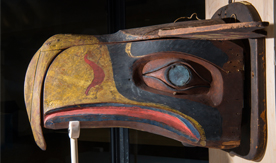
Seahawks Undefeated Since Inspirational Mask From Hudson Museum Delivered to Seattle
When the Seattle Seahawks lost 24–20 to the Kansas City Chiefs on Nov. 16, 2014, the defending Super Bowl champions were 6–4 and reeling.
But a week later, the Seahawks won the first of six straight regular-season contests. In the ensuing Divisional Playoff, the top-seeded Seahawks trounced the Carolina Panthers, then clinched a have-to-see-it-to-believe-it 28–22 victory over Green Bay in the NFC title game.
Some followers say Seattle’s resurgence might be attributed to several factors — key players became healthy, teammates aired their grievances and Percy Harvin was traded.
Gretchen Faulkner, director of the Hudson Museum at the University of Maine, has another theory.
On Nov. 18, two days before Seattle began its return to glory, the transformation mask that inspired the Seahawks logo was unveiled at the Burke Museum at the University of Seattle, Washington. The Hudson Museum had loaned the mask to the Burke Museum to be included in its Here & Now: Native Artists Inspired exhibit that runs until July 27, 2015.
A Kwakwaka‘wakw (kwock-KWOCKY-wowk) artist or artists carved the cedar mask in the late 19th or early 20th century. Kwakwaka‘wakw is an Indigenous people of the Pacific Northwest Coast. The brightly colored cedar mask has mirrors for eyes. When closed, it’s 2 feet long and depicts a bird of prey. When open, it’s 3 feet long and reveals a painted representation of a human face. Masks are traditionally worn in Kwakwaka’wakw ceremonies that include singing, dancing and giving gifts, and often memorialize a deceased chief.
The mask was in good company at the Seattle unveiling, where Kwakwaka‘wakw community members George Me’las Taylor and Andy Tanis Everson blessed the mask and performed a welcome dance. Jim Zorn, Seattle quarterback from 1976–81, also spoke. The Lombardi trophy was situated nearby.
Faulkner traveled to the West Coast for the unveiling at the Burke Museum, which raised funds to have the mask transported across country.
She is pleased the people of Seattle can view the mask in person. But she hopes any luck the mask may have brought to the Seahawks runs out before Sunday, Feb. 1, when they face off with the Patriots in Super Bowl XLIX in Glendale, Arizona.
Faulkner delivered remarks at the celebratory event, saying, “When you live in Maine, you don’t customarily root for the Seahawks, but [2014] was an exception, as among the collection of the Hudson Museum at the University of Maine was a mask linked to the team.”
She noted other connections that UMaine has with New England’s beloved Patriots and the Seahawks. In 2005, the Seahawks drafted Mosiula Mea’alofa Tatupu, who played one year of college football for the Black Bears. Tatupu’s father, Mosi Tatupu, played 13 seasons for the Pats, from 1978 to 1990. In addition, the transformation mask was once owned by artist Max Ernst, who, for a time, lived in Arizona, the state where the Super Bowl is being played.
Faulkner has issued a friendly wager with Burke Museum counterpart Julie Stein. If Seattle wins the contest, Faulkner says she’ll ship a “lobstah dinner” to Stein. If the Patriots win, Stein will send a Dungeness crab feast to Faulkner.
Faulkner says Richard Emerick, the late UMaine anthropologist and founder of the Hudson Museum, told her years ago the wooden mask was the inspiration for the Seahawks logo that was introduced in 1975. But there was no corroborating information in the mask’s collection file linking it to the team. In 1982, avid baseball fan William Palmer of Falmouth Foreside, Maine, had bequeathed the mask, as well as other Northwest Coast art and an extraordinary collection of Pre-Colombian artifacts, to UMaine.
After the Seahawks Super Bowl win over the Denver Broncos on Sunday, Feb. 2, 2014, Faulkner told museum board member Isla Baldwin what Emerick had shared with her years before. While researching online, Baldwin discovered a blog written by Robin K. Wright, curator of Native American art and director of the Bill Holm Center at Burke Museum.
A few days before Super Bowl XLVIII, Wright posted a blog “Searching for what inspired the Seattle Seahawks logo.” In her blog, Wright attributed the mask to the Kwakwaka‘wakw and included a photograph of the inspiration mask from Robert Bruce Inverarity’s 1950 book, “Art of the Northwest Coast Indians.”
The mask in the photograph was the same mask displayed at the Hudson Museum, catalogue number HM5521.
In a televised interview just prior to the Super Bowl, Wright said she hoped the blog and TV interview might unearth the location of the mask.
That it did. And it set in motion a number of interesting events.
Contact: Beth Staples, 207.581.3777
